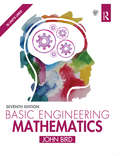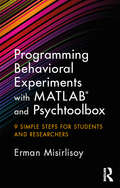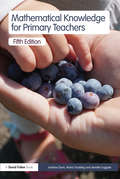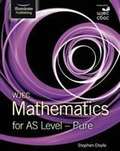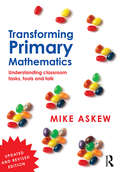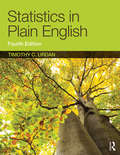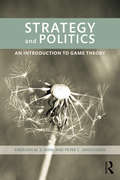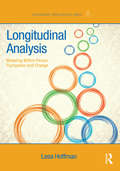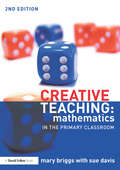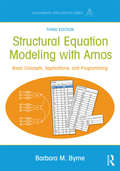- Table View
- List View
Basic Engineering Mathematics
by John BirdNow in its seventh edition, Basic Engineering Mathematics is an established textbook that has helped thousands of students to succeed in their exams. Mathematical theories are explained in a straightforward manner, being supported by practical engineering examples and applications in order to ensure that readers can relate theory to practice. The extensive and thorough topic coverage makes this an ideal text for introductory level engineering courses. This title is supported by a companion website with resources for both students and lecturers, including lists of essential formulae, multiple choice tests, and full solutions for all 1,600 further questions.
Engineering Mathematics
by John BirdNow in its eighth edition, Engineering Mathematics is an established textbook that has helped thousands of students to succeed in their exams. John Bird's approach is based on worked examples and interactive problems. Mathematical theories are explained in a straightforward manner, being supported by practical engineering examples and applications in order to ensure that readers can relate theory to practice. The extensive and thorough topic coverage makes this an ideal text for a range of Level 2 and 3 engineering courses. This title is supported by a companion website with resources for both students and lecturers, including lists of essential formulae and multiple choice tests.
Engineering Mathematics
by John BirdNow in its eighth edition, Engineering Mathematics is an established textbook that has helped thousands of students to succeed in their exams. John Bird's approach is based on worked examples and interactive problems. Mathematical theories are explained in a straightforward manner, being supported by practical engineering examples and applications in order to ensure that readers can relate theory to practice. The extensive and thorough topic coverage makes this an ideal text for a range of Level 2 and 3 engineering courses. This title is supported by a companion website with resources for both students and lecturers, including lists of essential formulae and multiple choice tests.
Programming Behavioral Experiments with MATLAB and Psychtoolbox: 9 Simple Steps for Students and Researchers
by Erman MisirlisoyHuman behavior is fascinating so it’s no surprise that psychologists and neuroscientists spend their lives designing rigorous experiments to understand it. MATLAB is one of the most widely used pieces of software for designing and running behavioral experiments, and it opens up a world of quick and flexible experiment programming. This book offers a step-by-step guide to using MATLAB with Psychtoolbox to create customisable experiments. Its pocket size and simple language allow you to get straight to the point and help you to learn fast in order to complete your work in great time. In nine simple steps, it guides you all the way from setting parameters for your experiment to analysing the output. Gone are the daunting days of working through hundreds of irrelevant and complicated documents, as in this handy book, Erman Misirlisoy coaxes you in the right direction with his friendly and encouraging tricks and tips. If you want to learn how to develop your own experiments to collect and analyse behavioral data, then this book is a must-read. Whether you are a student in experimental psychology, a researcher in cognitive neuroscience, or simply someone who wants to run behavioral tasks on your friends for fun, this book will offer you the skills to succeed.
Mathematical Knowledge for Primary Teachers
by Andrew Davis Maria Goulding Jennifer SuggateNow in its fifth edition, the best-selling text Mathematical Knowledge for Primary Teachers provides trainee teachers with clear information about the fundamental mathematical ideas taught in primary schools. With rigorous and comprehensive coverage of all the mathematical knowledge primary teachers need, the text goes beyond rules and routines to help readers deepen their understanding of mathematical ideas and increase their confidence in teaching these ideas. The book has been updated to incorporate changes in the National Curriculum and the associated tests. In addition, Chapter 1 has been expanded to discuss mathematical understanding in the light of the challenges posed by the current changes. These include the re-introduction of traditional calculation methods for multiplication and division, the early coverage of abstract fractions calculations and much more. Features include: ? ‘Check’ questions to test the reader’s understanding ? ‘Challenges’ to increase teachers’ confidence and stretch their mathematical abilities ? ‘Links with the classroom’ to emphasise the relevance of ideas to the classroom context ? Straightforward coverage from theory to practice for all aspects of the Mathematics Framework. The book is accompanied by a website which contains further visual activities and support, designed to scaffold and support the reader’s own understanding. Essential reading for all practising and trainee primary teachers, this book is ideal for those who wish to increase their mathematical understanding and confidence in presenting mathematics in the classroom.
From Numbers to Words: Reporting Statistical Results for the Social Sciences
by Tom Reichert Susan Morgan Tyler R. HarrisonThis invaluable resource guides readers through the process of creating scholarly, publishable prose from the results of quantitative experiments and investigations. It delves into the issues commonly encountered when reporting the results of statistical experiments and investigations, and provides instruction re the representation of these results in text and visual formats. This unique research companion serves as a must-have reference for advanced students doing quantitative research and working with statistics, with the goal of writing up and publishing their findings; it also serves as a useful refresher for experienced researchers.
WJEC Mathematics for AS Level - Pure (PDF)
by Stephen DoyleThe contents of this study and revision guide are designed to guide you through to success in the Pure Mathematics component of the WJEC Mathematics for AS Level: Pure examination. It has been written by an experienced author and teacher.
Transforming Primary Mathematics: Understanding classroom tasks, tools and talk
by Mike AskewFully updated to reflect the new curriculum, the revised edition of Transforming Primary Mathematics sets out key theories and cutting-edge research in the field to enable teachers to take a fresh look at how they teach mathematics. The book encourages teachers to reflect on their own beliefs and values about mathematics, and asks them to question whether their current methods meet the needs of all learners, and the challenge of having high expectations for all. It provides clear, practical approaches to help implement fundamental change in classroom environments, and offers motivational teaching styles to ensure meaningful mathematics learning. Chapters take an inspiring, sometimes controversial, and often unconventional look at the subject of mathematics, by: endorsing the use of a ‘new mathematics’ – one based on problem solving, modelling, inquiry and reasoning, not on abstract rules, memorising, and regurgitation arguing that there is more to maths teaching than ‘death by a thousand worksheets’ challenging norms, such as the practice of sorting children into sets based on their perceived mathematical ability asking whether mathematical ability is innate or a result of social practices examining what a ‘mastery’ approach might entail highlighting the role of variation in supporting learning advocating an environment where teachers are encouraged to take risks. Transforming Primary Mathematics is for all primary school teachers who want to make mathematics welcoming, engaging, inclusive and successful.
Migration (Key Ideas in Geography)
by Michael Samers Michael CollyerWhile the subject of migration has received enormous attention in academic journals and books across the social sciences, introductory texts on the matter are few and far between. Even fewer books have explored migration through a critical and explicit engagement with spatial concepts. Now in its second edition, Migration remains the only text in more than a decade that emphasizes how geographical or spatial concepts can be used critically to understand migration. The multi-disciplinary text draws on insights from human geography, political science, social anthropology, sociology, and to a lesser extent economics. All of the chapters focus on key terms, theories, concepts, and issues concerning migration and immigration. The book argues that in the context of migration, two opposing ‘spatial positions’ have emerged in the wake of the critique of ‘methodological nationalism’. On one hand is the significance of ‘transnationalism’, and on the other, the importance of ‘sub-national’ or local processes. Both require more nuance and integration, while many of the concepts and theories which have thus far neglected space or have not been ‘treated’ spatially, need to be re-written with space in mind. Pedagogically the text combines a carefully defined structure, accessible language, boxes that explore case studies of migrant-related experiences in particular places, annotated suggestions for further reading, useful websites and relevant films and summary questions for student learning at the end of each chapter. Migration provides a critical, multi-disciplinary, advanced, and theoretically informed introduction to migration and immigration. Revised and updated with new material, new maps and illustrations and an accompanying website (https://migration2ndedition.wordpress.com/), it continues to be aimed at advanced undergraduates and Masters-level graduate students undertaking courses on migration and immigration.
The Data Game: Controversies in Social Science Statistics
by Mark Maier Jennifer ImazekiThis book introduces students to the collection, uses, and interpretation of statistical data in the social sciences. It would suit all social science introductory statistics and research methods courses. Separate chapters are devoted to data in the fields of demography, housing, health, education, crime, the economy, wealth, income, poverty, labor, business statistics, and public opinion polling, with a concluding chapter devoted to the common problem of ambiguity. Each chapter includes multiple case studies illustrating the controversies, overview of data sources including web sites, chapter summary and a set of case study questions designed to stimulate further thought.
The Data Game: Controversies in Social Science Statistics
by Mark Maier Jennifer ImazekiThis book introduces students to the collection, uses, and interpretation of statistical data in the social sciences. It would suit all social science introductory statistics and research methods courses. Separate chapters are devoted to data in the fields of demography, housing, health, education, crime, the economy, wealth, income, poverty, labor, business statistics, and public opinion polling, with a concluding chapter devoted to the common problem of ambiguity. Each chapter includes multiple case studies illustrating the controversies, overview of data sources including web sites, chapter summary and a set of case study questions designed to stimulate further thought.
Introduction to the New Statistics: Estimation, Open Science, and Beyond
by Geoff Cumming Robert Calin-JagemanThis is the first introductory statistics text to use an estimation approach from the start to help readers understand effect sizes, confidence intervals (CIs), and meta-analysis (‘the new statistics’). It is also the first text to explain the new and exciting Open Science practices, which encourage replication and enhance the trustworthiness of research. In addition, the book explains NHST fully so students can understand published research. Numerous real research examples are used throughout. The book uses today’s most effective learning strategies and promotes critical thinking, comprehension, and retention, to deepen users’ understanding of statistics and modern research methods. The free ESCI (Exploratory Software for Confidence Intervals) software makes concepts visually vivid, and provides calculation and graphing facilities. The book can be used with or without ESCI. Other highlights include: - Coverage of both estimation and NHST approaches, and how to easily translate between the two. - Some exercises use ESCI to analyze data and create graphs including CIs, for best understanding of estimation methods. -Videos of the authors describing key concepts and demonstrating use of ESCI provide an engaging learning tool for traditional or flipped classrooms. -In-chapter exercises and quizzes with related commentary allow students to learn by doing, and to monitor their progress. -End-of-chapter exercises and commentary, many using real data, give practice for using the new statistics to analyze data, as well as for applying research judgment in realistic contexts. -Don’t fool yourself tips help students avoid common errors. -Red Flags highlight the meaning of "significance" and what p values actually mean. -Chapter outlines, defined key terms, sidebars of key points, and summarized take-home messages provide a study tool at exam time. -http://www.routledge.com/cw/cumming offers for students: ESCI downloads; data sets; key term flashcards; tips for using SPSS for analyzing data; and videos. For instructors it offers: tips for teaching the new statistics and Open Science; additional homework exercises; assessment items; answer keys for homework and assessment items; and downloadable text images; and PowerPoint lecture slides. Intended for introduction to statistics, data analysis, or quantitative methods courses in psychology, education, and other social and health sciences, researchers interested in understanding the new statistics will also appreciate this book. No familiarity with introductory statistics is assumed.
Introduction to the New Statistics: Estimation, Open Science, and Beyond
by Geoff Cumming Robert Calin-JagemanThis is the first introductory statistics text to use an estimation approach from the start to help readers understand effect sizes, confidence intervals (CIs), and meta-analysis (‘the new statistics’). It is also the first text to explain the new and exciting Open Science practices, which encourage replication and enhance the trustworthiness of research. In addition, the book explains NHST fully so students can understand published research. Numerous real research examples are used throughout. The book uses today’s most effective learning strategies and promotes critical thinking, comprehension, and retention, to deepen users’ understanding of statistics and modern research methods. The free ESCI (Exploratory Software for Confidence Intervals) software makes concepts visually vivid, and provides calculation and graphing facilities. The book can be used with or without ESCI. Other highlights include: - Coverage of both estimation and NHST approaches, and how to easily translate between the two. - Some exercises use ESCI to analyze data and create graphs including CIs, for best understanding of estimation methods. -Videos of the authors describing key concepts and demonstrating use of ESCI provide an engaging learning tool for traditional or flipped classrooms. -In-chapter exercises and quizzes with related commentary allow students to learn by doing, and to monitor their progress. -End-of-chapter exercises and commentary, many using real data, give practice for using the new statistics to analyze data, as well as for applying research judgment in realistic contexts. -Don’t fool yourself tips help students avoid common errors. -Red Flags highlight the meaning of "significance" and what p values actually mean. -Chapter outlines, defined key terms, sidebars of key points, and summarized take-home messages provide a study tool at exam time. -http://www.routledge.com/cw/cumming offers for students: ESCI downloads; data sets; key term flashcards; tips for using SPSS for analyzing data; and videos. For instructors it offers: tips for teaching the new statistics and Open Science; additional homework exercises; assessment items; answer keys for homework and assessment items; and downloadable text images; and PowerPoint lecture slides. Intended for introduction to statistics, data analysis, or quantitative methods courses in psychology, education, and other social and health sciences, researchers interested in understanding the new statistics will also appreciate this book. No familiarity with introductory statistics is assumed.
Statistics in Plain English, Fourth Edition
by Timothy C. UrdanThis introductory textbook provides an inexpensive, brief overview of statistics to help readers gain a better understanding of how statistics work and how to interpret them correctly. Each chapter describes a different statistical technique, ranging from basic concepts like central tendency and describing distributions to more advanced concepts such as t tests, regression, repeated measures ANOVA, and factor analysis. Each chapter begins with a short description of the statistic and when it should be used. This is followed by a more in-depth explanation of how the statistic works. Finally, each chapter ends with an example of the statistic in use, and a sample of how the results of analyses using the statistic might be written up for publication. A glossary of statistical terms and symbols is also included. Using the author’s own data and examples from published research and the popular media, the book is a straightforward and accessible guide to statistics. New features in the fourth edition include: sets of work problems in each chapter with detailed solutions and additional problems online to help students test their understanding of the material, new "Worked Examples" to walk students through how to calculate and interpret the statistics featured in each chapter, new examples from the author’s own data and from published research and the popular media to help students see how statistics are applied and written about in professional publications, many more examples, tables, and charts to help students visualize key concepts, clarify concepts, and demonstrate how the statistics are used in the real world. a more logical flow, with correlation directly preceding regression, and a combined glossary appearing at the end of the book, a Quick Guide to Statistics, Formulas, and Degrees of Freedom at the start of the book, plainly outlining each statistic and when students should use them, greater emphasis on (and description of) effect size and confidence interval reporting, reflecting their growing importance in research across the social science disciplines an expanded website at www.routledge.com/cw/urdan with PowerPoint presentations, chapter summaries, a new test bank, interactive problems and detailed solutions to the text’s work problems, SPSS datasets for practice, links to useful tools and resources, and videos showing how to calculate statistics, how to calculate and interpret the appendices, and how to understand some of the more confusing tables of output produced by SPSS. Statistics in Plain English, Fourth Edition is an ideal guide for statistics, research methods, and/or for courses that use statistics taught at the undergraduate or graduate level, or as a reference tool for anyone interested in refreshing their memory about key statistical concepts. The research examples are from psychology, education, and other social and behavioral sciences.
Strategy and Politics: An Introduction to Game Theory
by Emerson Niou Peter C. OrdeshookStrategy and Politics: An Introduction to Game Theory is designed to introduce students with no background in formal theory to the application of game theory to modeling political processes. This accessible text covers the essential aspects of game theory while keeping the reader constantly in touch with why political science as a whole would benefit from considering this method. Examining the very phenomena that power political machineries—elections, legislative and committee processes, and international conflict, the book attempts to answer fundamental questions about their nature and function in a clear, accessible manner. Included at the end of each chapter is a set of exercises designed to allow students to practice the construction and analysis of political models. Although the text assumes only an elementary-level training in algebra, students who complete a course around this text will be equipped to read nearly all of the professional literature that makes use of game theoretic analysis.
Strategy and Politics: An Introduction to Game Theory
by Emerson Niou Peter C. OrdeshookStrategy and Politics: An Introduction to Game Theory is designed to introduce students with no background in formal theory to the application of game theory to modeling political processes. This accessible text covers the essential aspects of game theory while keeping the reader constantly in touch with why political science as a whole would benefit from considering this method. Examining the very phenomena that power political machineries—elections, legislative and committee processes, and international conflict, the book attempts to answer fundamental questions about their nature and function in a clear, accessible manner. Included at the end of each chapter is a set of exercises designed to allow students to practice the construction and analysis of political models. Although the text assumes only an elementary-level training in algebra, students who complete a course around this text will be equipped to read nearly all of the professional literature that makes use of game theoretic analysis.
Longitudinal Analysis: Modeling Within-Person Fluctuation and Change (Multivariate Applications Series)
by Lesa HoffmanLongitudinal Analysis provides an accessible, application-oriented treatment of introductory and advanced linear models for within-person fluctuation and change. Organized by research design and data type, the text uses in-depth examples to provide a complete description of the model-building process. The core longitudinal models and their extensions are presented within a multilevel modeling framework, paying careful attention to the modeling concerns that are unique to longitudinal data. Written in a conversational style, the text provides verbal and visual interpretation of model equations to aid in their translation to empirical research results. Overviews and summaries, boldfaced key terms, and review questions will help readers synthesize the key concepts in each chapter. Written for non-mathematically-oriented readers, this text features: A description of the data manipulation steps required prior to model estimation so readers can more easily apply the steps to their own data An emphasis on how the terminology, interpretation, and estimation of familiar general linear models relates to those of more complex models for longitudinal data Integrated model comparisons, effect sizes, and statistical inference in each example to strengthen readers’ understanding of the overall model-building process Sample results sections for each example to provide useful templates for published reports Examples using both real and simulated data in the text, along with syntax and output for SPSS, SAS, STATA, and Mplus at www.PilesOfVariance.com to help readers apply the models to their own data The book opens with the building blocks of longitudinal analysis—general ideas, the general linear model for between-person analysis, and between- and within-person models for the variance and the options within repeated measures analysis of variance. Section 2 introduces unconditional longitudinal models including alternative covariance structure models to describe within-person fluctuation over time and random effects models for within-person change. Conditional longitudinal models are presented in section 3, including both time-invariant and time-varying predictors. Section 4 reviews advanced applications, including alternative metrics of time in accelerated longitudinal designs, three-level models for multiple dimensions of within-person time, the analysis of individuals in groups over time, and repeated measures designs not involving time. The book concludes with additional considerations and future directions, including an overview of sample size planning and other model extensions for non-normal outcomes and intensive longitudinal data. Class-tested at the University of Nebraska-Lincoln and in intensive summer workshops, this is an ideal text for graduate-level courses on longitudinal analysis or general multilevel modeling taught in psychology, human development and family studies, education, business, and other behavioral, social, and health sciences. The book’s accessible approach will also help those trying to learn on their own. Only familiarity with general linear models (regression, analysis of variance) is needed for this text.
Creative Teaching: Mathematics in the Primary Classroom
by Mary Briggs Sue DavisThis stimulating text shows how primary mathematics can be creative, exciting and enjoyable. Offering teachers a dynamic and different perspective, it enables them to see and teach in creative ways that will develop their pupil’s mathematical thinking potential. Creative Teaching: Mathematics in the Primary Classroom encourages students, trainees and practicing teachers to envision and develop a classroom where children can take risks, enjoy and experiment with mathematical thinking, and discover and pursue their interests and talents in an imaginative yet purposeful way. This second edition contains key updates to reflect the changes to the primary curriculum and includes: new sections on: specialist teaching, parental engagement and approaches to homework; creative classroom environments; working walls, displays and outdoor settings; links to assessment, speaking, listening and learning theory; use of media, film, news and stories for creative learning; cross-curricula work. Featuring reflective tasks in every chapter, this book will prove essential and inspiring reading for all trainee and practising teachers looking to develop their creative practice. Aimed at primary and early years trainee teachers, NQTs and experienced teachers, this is a timely publication for teachers and schools seeking to broaden their maths curriculum, making it more creative and appealing to young minds.
Creative Teaching: Mathematics in the Primary Classroom
by Mary Briggs Sue DavisThis stimulating text shows how primary mathematics can be creative, exciting and enjoyable. Offering teachers a dynamic and different perspective, it enables them to see and teach in creative ways that will develop their pupil’s mathematical thinking potential. Creative Teaching: Mathematics in the Primary Classroom encourages students, trainees and practicing teachers to envision and develop a classroom where children can take risks, enjoy and experiment with mathematical thinking, and discover and pursue their interests and talents in an imaginative yet purposeful way. This second edition contains key updates to reflect the changes to the primary curriculum and includes: new sections on: specialist teaching, parental engagement and approaches to homework; creative classroom environments; working walls, displays and outdoor settings; links to assessment, speaking, listening and learning theory; use of media, film, news and stories for creative learning; cross-curricula work. Featuring reflective tasks in every chapter, this book will prove essential and inspiring reading for all trainee and practising teachers looking to develop their creative practice. Aimed at primary and early years trainee teachers, NQTs and experienced teachers, this is a timely publication for teachers and schools seeking to broaden their maths curriculum, making it more creative and appealing to young minds.
Structural Equation Modeling With AMOS: Basic Concepts, Applications, and Programming, Third Edition (Multivariate Applications Series)
by Barbara M. ByrneThis bestselling text provides a practical guide to structural equation modeling (SEM) using the Amos Graphical approach. Using clear, everyday language, the text is ideal for those with little to no exposure to either SEM or Amos. The author reviews SEM applications based on actual data taken from her own research. Each chapter "walks" readers through the steps involved (specification, estimation, evaluation, and post hoc modification) in testing a variety of SEM models. Accompanying each application is: an explanation of the issues addressed and a schematic presentation of hypothesized model structure; Amos? input and output with interpretations; use of the Amos toolbar icons and pull-down menus; and data upon which the model application was based, together with updated references pertinent to the SEM model? tested. Thoroughly updated throughout, the new edition features: All new screen shots featuring Amos Version 23.?? Descriptions and illustrations of Amos’ new Tables View format which enables the specification of a structural model in spreadsheet form.???? Key concepts and/or techniques that introduce each chapter. Alternative approaches to model analyses when enabled by Amos thereby allowing users to determine the method best suited to their data.? Provides analysis of the same model based on continuous and categorical data (Ch. 5) thereby enabling readers to observe two ways of specifying and testing the same model as well as compare results. All applications based on the Amos graphical mode interface accompanied by more "how to" coverage of graphical techniques unique to Amos. More explanation of key procedures and analyses that address questions posed by readers All application data files are available at www.routledge.com/9781138797031. The two introductory chapters in Section 1 review the fundamental concepts of SEM methodology and a general overview of the Amos program. Section 2 provides single-group analyses applications including two first-order confirmatory factor analytic (CFA) models, one second-order CFA model, and one full latent variable model. Section 3 presents multiple-group analyses applications with two rooted in the analysis of covariance structures and one in the analysis of mean and covariance structures. Two models that are increasingly popular with SEM practitioners, construct validity and testing change over time using the latent growth curve, are presented in Section 4. The book concludes with a review of the use of bootstrapping to address non-normal data and a review of missing (or incomplete) data in Section 5. An ideal supplement for graduate level courses in psychology, education, business, and social and health sciences that cover the fundamentals of SEM with a focus on Amos, this practical text continues to be a favorite of both researchers and practitioners. A prerequisite of basic statistics through regression analysis is recommended but no exposure to either SEM or Amos is required.
Statistical Power Analysis: A Simple and General Model for Traditional and Modern Hypothesis Tests, Fourth Edition
by Kevin R. Murphy Brett Myors Allen WolachNoted for its accessible approach, this text applies the latest approaches of power analysis to both null hypothesis and minimum-effect testing using the same basic unified model. Through the use of a few simple procedures and examples, the authors show readers with little expertise in statistical analysis how to obtain the values needed to carry out the power analysis for their research. Illustrations of how these analyses work and how they can be used to choose the appropriate criterion for defining statistically significant outcomes are sprinkled throughout. The book presents a simple and general model for statistical power analysis based on the F statistic and reviews how to determine: the sample size needed to achieve desired levels of power; the level of power needed in a study; the size of effect that can be reliably detected by a study; and sensible criteria for statistical significance. The book helps readers design studies, diagnose existing studies, and understand why hypothesis tests come out out the way they do. The fourth edition features: -New Boxed Material sections provide examples of power analysis in action and discuss unique issues that arise as a result of applying power analyses in different designs. -Many more worked examples help readers apply the concepts presented. -Expanded coverage of power analysis for multifactor analysis of variance (ANOVA) to show readers how to analyze up to four factors with repeated measures on any or all of the factors. -Re-designed and expanded web based One Stop F Calculator software and data sets that allow users to perform all of the book's analyses and conduct significance tests, power analyses, and assessments of N and alpha needed for traditional and minimum-effects tests. -Easy to apply formulas for approximating the number of subjects required to reach adequate levels of power in a wide range of studies. Intended as a supplement for graduate/advanced undergraduate courses in research methods or experimental design, intermediate, advanced, or multivariate statistics, statistics II, or psychometrics, taught in psychology, education, business, and other social and health sciences, researchers also appreciate the book‘s applied approach.
Statistical Power Analysis: A Simple and General Model for Traditional and Modern Hypothesis Tests, Fourth Edition
by Kevin R. Murphy Brett Myors Allen WolachNoted for its accessible approach, this text applies the latest approaches of power analysis to both null hypothesis and minimum-effect testing using the same basic unified model. Through the use of a few simple procedures and examples, the authors show readers with little expertise in statistical analysis how to obtain the values needed to carry out the power analysis for their research. Illustrations of how these analyses work and how they can be used to choose the appropriate criterion for defining statistically significant outcomes are sprinkled throughout. The book presents a simple and general model for statistical power analysis based on the F statistic and reviews how to determine: the sample size needed to achieve desired levels of power; the level of power needed in a study; the size of effect that can be reliably detected by a study; and sensible criteria for statistical significance. The book helps readers design studies, diagnose existing studies, and understand why hypothesis tests come out out the way they do. The fourth edition features: -New Boxed Material sections provide examples of power analysis in action and discuss unique issues that arise as a result of applying power analyses in different designs. -Many more worked examples help readers apply the concepts presented. -Expanded coverage of power analysis for multifactor analysis of variance (ANOVA) to show readers how to analyze up to four factors with repeated measures on any or all of the factors. -Re-designed and expanded web based One Stop F Calculator software and data sets that allow users to perform all of the book's analyses and conduct significance tests, power analyses, and assessments of N and alpha needed for traditional and minimum-effects tests. -Easy to apply formulas for approximating the number of subjects required to reach adequate levels of power in a wide range of studies. Intended as a supplement for graduate/advanced undergraduate courses in research methods or experimental design, intermediate, advanced, or multivariate statistics, statistics II, or psychometrics, taught in psychology, education, business, and other social and health sciences, researchers also appreciate the book‘s applied approach.
A Guide to Doing Statistics in Second Language Research Using SPSS and R (Second Language Acquisition Research Series)
by Jenifer Larson-HallA Guide to Doing Statistics in Second Language Research Using SPSS and R, Second Edition is the only text available that demonstrates how to use SPSS and R as specifically related to applied linguistics and SLA research. This new edition is up-to-date with the most recent version of the SPSS software and now also includes coverage of R, a software program increasingly used by researchers in this field. Supported by a number of pedagogical features, including tip boxes and practice activities, and a wealth of screenshots, this book takes readers through each step of performing and understanding statistical research, covering the most commonly used tests in second language research, including t-tests, correlation, and ANOVA. A robust accompanying website covers additional tests of interest to students and researchers, taking them step-by-step through carrying out these tests themselves. In this comprehensive and hands-on volume, Jenifer Larson-Hall equips readers with a thorough understanding and the practical skills necessary to conducting and interpreting statisical research effectively using SPSS and R, ideal for graduate students and researchers in SLA, social sciences, and applied lingustics. For more information and materials, please visit www.routledge.com/cw/larson-hall.
An Introduction to Psychological Tests and Scales
by Kate Loewenthal Christopher Alan LewisIn its first edition this book successfully enabled readers, with little or no prior knowledge of computing or statistics, to develop reliable and valid tests and scales for assessment or research purposes. In this edition, the author has thoroughly updated the text to include new recent advances in computer software and provide information on relevant internet resources. The book contains detailed guidelines for locating and constructing psychological measures, including descriptions of popular psychological measures and step-by-step instructions for composing a measure, entering data and computing reliability and validity of test results. Advanced techniques such as factor analysis, analysis of covariance and multiple regression analysis are presented for the beginner.An Introduction to Psychological Tests and Scales provides a clear, concise and jargon-free primer for all those embarking in fieldwork or research analysis. It will be an invaluable tool for undergraduates and postgraduates in psychology and a useful text for students and professionals in related disciplines.
An Introduction to Psychological Tests and Scales
by Kate Loewenthal Christopher Alan LewisIn its first edition this book successfully enabled readers, with little or no prior knowledge of computing or statistics, to develop reliable and valid tests and scales for assessment or research purposes. In this edition, the author has thoroughly updated the text to include new recent advances in computer software and provide information on relevant internet resources. The book contains detailed guidelines for locating and constructing psychological measures, including descriptions of popular psychological measures and step-by-step instructions for composing a measure, entering data and computing reliability and validity of test results. Advanced techniques such as factor analysis, analysis of covariance and multiple regression analysis are presented for the beginner.An Introduction to Psychological Tests and Scales provides a clear, concise and jargon-free primer for all those embarking in fieldwork or research analysis. It will be an invaluable tool for undergraduates and postgraduates in psychology and a useful text for students and professionals in related disciplines.
